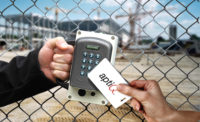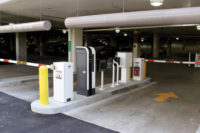Parking and gate control is not for the uninitiated. By nature exposed to the elements and often challenging, it has traditionally been the realm of integrators that specialize in it. Often a separate system and frequently dictated by regulations (particularly on the government side), it may not be something that has come up often for the traditional security systems integrator that works inside the building. Increasingly, however, no technology is separate and the demand for integration with access control, surveillance and other systems means that — whether you do it yourself or subcontract it — the perimeter is growing in importance as part of the whole security picture.
Like locks, which were often the purview of the locksmith (but now with integrated locksets the integrator is touching the door more and more), parking and gate controls are something you may need to think about and plan for. SDM spoke with four integrators well versed in parking and gate controls to discuss trends in integration, high security, and their most challenging installations ever.
Jack DeMao, CEO, Electric Guard Dog LLC, Columbia, S.C.; Lori Flower, vice president of sales, Global Access Control Systems, Pittsburgh; Tim Morgan, president, Mid-Atlantic Entry Systems, Sandston, Va.; and Dan Bazely, electrical engineer, Nasatka Security, Clinton, Md., shared their expertise and offered advice.
SDM: What is your involvement in parking and gate control and how has it changed in recent years?
DeMao: We do electric security fencing so we come inside the property 3 to 7 inches. Inside the existing fence we build our own and bracket it to the gate. In the old days they would bring us in and deal with the electric gate supplier separately. Now as a minimum they want us to integrate with the gate itself so they can press one button for access that opens the gate and shuts off electricity to that gate at the same time. Then ideally they would like that action integrated with their access control, so they want a report from us of who entered. Many times they will ask us to integrate that with video that we have supplied or they already have.
More dealers have to deal with parking and gates than in the past. The people signing checks are willing to pay more, but they are looking for integrated solutions and less pressure on operational personnel. Our particular expertise is in the area of parking commercial equipment such as parking trailers and tractors, in certain cases containers and large rolling stock. Ours wouldn’t be the average car parking garage. But I think similar trends affect both.
Flower: My partner is a second-generation locksmith. He dabbled in access control but it was a traditional locksmith company. [Global ACS] came into existence because we had some corporate accounts that were struggling to manage the installation portion of the hardware we were selling them. We first got into parking with a [rental company at a] local airport whose parking equipment had been down for almost six months. They asked us to troubleshoot it. My partner is a pretty mechanically inclined guy. He took one section apart and worked with the manufacturer to fix it. The rental car industry is a very unique niche within parking control solutions. They are very tight-knit with their competitors. It snowballed very quickly.
Traffic control is more of an industrial product. But some things that are increasing include the integration of a piece of equipment to other security measures such as being able to automatically open that gate through an RFID reader. That isn’t traffic control; that is actually access control. But it provides better integration with other security components to make a better solution.
Morgan: We have been in business for 25 years. We are what we call a perimeter security company. Everything we do is on the perimeter — until recently. We opened up an integration division that moves us a little more inside of the building into card access, door locks, CCTV work, etc. Our bread and butter is motorizing gates, whether residential, light commercial/industrial, all the way to anti-terrorist protection work.
The reason we got into integration was for years we had stayed on the perimeter. We started moving inside because of competition. There are more people doing what we do now than 19 years ago. In order for us to keep our volume of work we have taken what we know about the perimeter and moved to the inside of the building. I had the opportunity to bring someone on that came from the integration side.
Bazely: Nasatka is a perimeter security company. We do vehicle gates and barriers you see on government military sites. We have lower rated ones for commercial use but we mostly do crash-rated vehicle barriers. Now people are bringing in cameras and access control integrated with vehicle barriers — all in one system. That way if someone hits the barrier or the vehicle analytics system detects an oncoming car at a high rate of speed it can make decisions on what do with both barriers and personnel.
SDM: Has the demand for high-security solutions increased, either due to terrorism concerns, mass shootings or other factors?
Flower: I don’t see a huge change in technology; it’s more an increase of what is actually being done. There are events we do on a recurring basis and what I see changing is the amount of comprehensive coverage of a geographic area. Think of a mile of a city block: If a few years ago we had two or three gates covering that now it has at least increased by 30 to 50 percent in coverage of security. We also have several chemical manufacturing plants that are taking great measures to improve the amount of security and comprehensive layers occurring at vehicular checkpoints along their perimeter. They want the ability to know if someone even touches fences, with notification capabilities. In general there are a lot of regulations for facilities that handle hazardous materials and we see an increase in enforcement and inspection of those.
We also do a lot of school projects, which is more of a regional solution for us. I am seeing increased requests to properly lock down sections of or the entire campus through security measures. What area of a campus is least secure? It is that exterior perimeter. If you visualize a corporate or college campus a lot of them don’t have a defined perimeter. It would send the wrong message to throw fencing around that perimeter. But they are much more conscientious about students having IDs on them at all times. And they are starting to create checkpoints, to have controlled understanding of who is on or off campus.
Bazely: We are mainly government and military, but we do see some more commercial work such as rental car facilities, or auction houses where people are trying to deter would-be thieves. Not so much with terrorist threats, but the oil and gas industry has their own new set of rules they are trying to comply with called CFATS. That is making them have to get vehicle barriers. We have also done some colleges where they have WMD research. They fall under the need to have protected facilities.
Morgan: Our biggest years in high security government work were 2002 to 2004 when all of the naval bases in our area started hardening their perimeters. Now things are levelled out. In general our industry tends to be about six months behind [world events]. If you call me in six months and ask if we were affected by all the things going on recently I feel like we will see a big influx of work based on those things. In non-government, data centers are huge right now — credit card companies and anyone storing any software data for whatever reason.
DeMao: I would say we are impacted somewhat indirectly by terrorism. Commercial entities look to deterrent systems to push bad guys away because law enforcement resources have been stretched too thin and they don’t have enough resources to focus on property crime. That has been a long-term trend. Now with the increasing need to focus on terrorism there are even fewer resources available to address property crime. Customers and prospects feel it so they have to protect themselves.
One of the interesting intersections of commercial crime and terrorism is the government is concerned about commercial theft funding terror activities. Then, because the government is concerned about that, there are a number of initiatives from Homeland Security asking commercial companies to be proactive to prevent terrorism. We get people contacting us for two reasons. One is to comply with these initiatives from Homeland Security. The other one is because they are even more worried now about limited resources from law enforcement.
SDM: What are some of the more challenging aspects of your work in parking and gate controls?
Bazely: Weather can play a role in how your equipment works and how you bill for it. For example, part of our products live underground, so when we don’t have drains clear, electronics under water don’t really work that well. In the heat, we may need air conditioned equipment based on where it is going and the heat ratings. Weather and location can play a role in how you prepare for jobs.
DeMao: Everything is harder outside because it is in an uncontrolled environment, which is more challenging. What are you going to do when it snows? Or sometimes plans will look great the way you drew them out but then you find out that ravine floods periodically. Now what are you going to do?
Another issue is it is hard for a customer to always visualize how they are going to want a site to operate and what they will want us to do. Sometimes we have that same problem when we look at a site. Trying to anticipate all the complications and/or opportunities that will come up in a big installation is hard. The customer will assume their way of life is standard, but everybody’s standard is very different.
Flower: When you say parking control, 99 percent of Americans think the gate that goes up and down. But when you talk about crash gate arms and pieces of equipment that are government rated, now you are talking about a very specialized solution. True traffic control solutions are still a beast that many don’t want to mess with. Those gates could kill someone or damage something. Improper installation could result in people being injured.
In perimeter security, often when people are asking for these types of solutions it falls into one of two classifications: the first is they have budgeted for it, but the second is an unanticipated problem occurs and they need to immediately address the issue. When you are dealing with that second issue, the level of stress is escalated. Gates aren’t just sitting in a warehouse waiting to be shipped out.
Morgan: UL requirements have gotten stricter since January 12 of this year. (The new guidelines, called UL 325, say gate operators bearing the UL Label are now required to stop working if the safety devices such as photo eyes or sensing edges are not functioning properly.)
Post January 12, 2016, all motorized gates have to have at least two monitored safety devices. Then any entrapment areas — which vary from job to job — have to be protected by monitored devices. These are essentially like a heartbeat. That device protecting the entrapment area is sending a signal to a controller letting it know that it is functioning. If the operator doesn’t receive that signal it will go into shut-down. It makes the job harder.
SDM: What have you learned on the job that could help others?
Morgan: What we have learned is by using the PLC (programmable logic controller) we can do a whole lot more with the equipment we are installing as it pertains to sequencing the equipment and having things work together better, rather than just trying to tie them together the way they come out of the box. We have gone into facilities that had older technology already in place and can take and write PLC programs that allow us to leave it in place.
DeMao: We try to ask customers as many questions as we can think of; unfortunately, the way we learn about something we missed is when that ravine floods for the first time and we never thought to ask that question. We are celebrating our 25th year this year and we have a number of people who have been with us that long. We may think we have learned to ask every question but we are always learning new things. The last interesting question we added this year, for example, is about terrain. “Is the current condition we are in the way it normally is, or is it normally excessively dry or wet?” We find we are installing in some areas that are in relative drought or flood conditions. There may be very little vegetation in an area and we put a fence in; then a normal amount of rain comes, and that area becomes a jungle.”
Flower: This is not rocket science; but it is also not something anyone can walk up to and become a master at. You have to be mechanically inclined but also work with software platforms. We don’t just throw equipment in and bolt it down. We are certified to go into programming of the boards and that serves us very well. There are companies out there that try to do this work. We make a lot of money on fixing what wasn’t done right the first time. There are other companies out there that when they have a component, they send it to us. They know we can provide that portion for them.
We have learned to play very well with others and that is part of our recipe for success. We are a smaller security company, even though we have a national reach. Because of how we manage our projects and work and partner with other companies, we often act as a subcontractor for others. When you work with others, you both get more business.
Quotes
“Our most challenging would be a major location for Pitt Ohio, a regional trucking company. The project was to integrate with all their other security, including electric gates, zones and traffic lights. We thought we understood what they needed at the beginning and they understood as well. We pre-built the electronics and everything else; but when got there it became apparent to us and them what additional things they needed. It is always a challenge when you start with plan A and then have to come up with plan B.” — Jack DeMao, Electric Guard Dog
“Our most challenging installation was for a large important political event during the summer in Florida. The timing was such that there were hurricane warnings. We had two main venues where we were providing Delta crash gates to set up and control entry points into event areas — one at a convention center and one in downtown. The event we were working was extremely time sensitive and the vehicle barriers had to be relocated from one location to another overnight, which happened to be in the middle of the hurricane. Without that happening it would have postponed the ability to have the event the next day.” — Lori Flower, Global Access Control Systems
“We have barriers at the Supreme Court and all around Capitol Hill. The Court has around 20 barriers with touchscreens and a redundant communication network as well. It wasn’t too difficult, but it was one of our first projects with Cinch Systems and one of our largest installations, with 20 barriers. It was probably one of the more difficult in the beginning because it was a whole new system and we were putting it on a large-scale map.” — Dan Bazely, Nasatka Security
“We hardened the perimeter of a government facility probably five or six years ago with anti-terrorist wedge barriers. It was a standard job when we quoted it — barriers up, barriers down to control traffic coming and going from facility. We went to the pre-construction meeting and the user of the building (they lease) had this list of things they wanted to be able to do, a sequence of operations. What we did is finalized that sequence of operation and had our in-house IT person write and do everything in a PLC. This is so memorable to me because it was our first job where we did programmable logic controller work. We had to write the sequence and the one for entering is slightly different than for exiting. We were controlling not only barriers but wedge arms and safety devices involved in the whole process.” — Tim Morgan, Mid-Atlantic Entry Systems
More Online:
For more on parking at gates, seeSDM’s website, where you find the following articles:
“Choosing, Designing and Installing Parking and Gate Systems”
“Parking & Gate Best Practices”
“5 Projects That Improved Parking Security”







